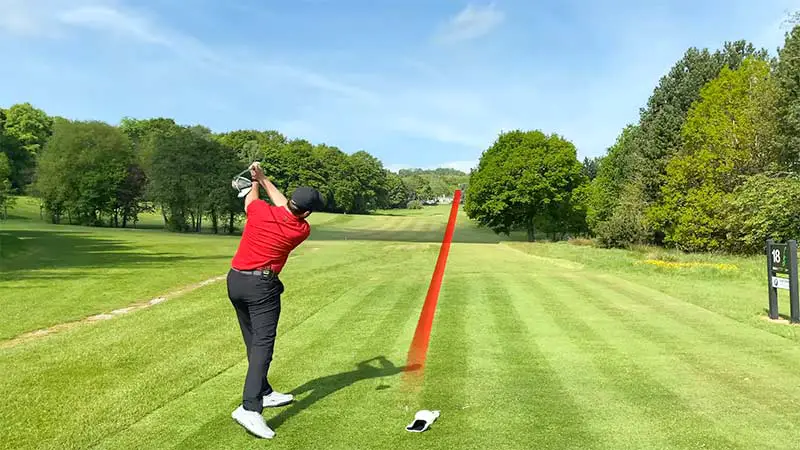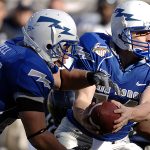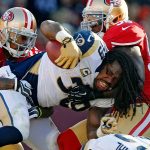Picture this: you’re on the golf course, the sun is shining, and you’re ready to unleash a powerful drive down the fairway.
But instead, your golf ball takes a detour, veering off to the right (or left for left-handed golfers), ruining your shot and your scorecard. What happened? You just experienced the dreaded golf slice.
If you’re one of the more than 25 million Americans who played a round of golf last year, you know that few things are as frustrating as a persistent slice.
It’s the kind of shot that can send your ball careening into the rough, the trees, or even the neighboring fairway.
But fear not! In this guide, we’ll demystify the golf slice and equip you with the knowledge and tools to tackle it head-on. Get ready to enjoy straighter, more accurate shots and a more enjoyable time on the course.
Understanding a Golf Slice
Understanding a golf slice involves grasping its causes and solutions. A slice occurs when the ball veers to the right (for right-handed golfers) or to the left (for left-handed golfers) uncontrollably.
It’s typically caused by sidespin imparted on the ball due to an open clubface at impact and an outside-to-inside swing path.
What Is a Golf Slice?
A golf slice is a shot that curves in the air from left to right for right-handed golfers and from right to left for left-handed golfers. It’s the opposite of a hook, which curves in the opposite direction.
Slices significantly reduce distance and accuracy, often leading to missed fairways and higher scores. The slice is notorious among golfers for being a persistent problem that can derail gameplay.
Understanding why a slice occurs is the first step to fixing it. Common causes include an open clubface at impact, an outside-in swing path, and improper grip or stance.
Correcting these issues involves adjusting your grip, ensuring a proper stance, and practicing drills that promote an inside-out swing path.
Common Causes of a Golf Slice
Several factors contribute to a golf slice, and identifying them is essential to correcting the issue:
- Swing Path: An out-to-in swing path is a frequent cause of a slice. When the club approaches the ball from outside the target line, it creates side spin, sending the ball on a slicing trajectory. Focus on an inside-out path to counter this.
- Grip: A poor grip is often the primary cause of slicing. If the club is held mainly in the palm of your lead hand and your trail hand is placed on top of the shaft, squaring the clubface becomes difficult. This grip usually leads to weak shots veering to the right.
- Clubface Angle: The angle of the clubface at impact plays a crucial role. If the clubface is open relative to the swing path, it imparts a left-to-right spin on the ball, resulting in a slice. Ensure the clubface is neutral or slightly closed at impact.
- Equipment: Using equipment not suited to your swing can exacerbate slicing. A driver with insufficient loft or the wrong type of golf ball can increase the likelihood of a slice. Ensure your equipment fits your swing profile.
Essentials of Golf Slice Correction
Correcting a golf slice involves understanding its root causes and implementing targeted adjustments.
Here are the essentials for fixing a slice:
Assessing Your Grip and Stance
Start by evaluating your grip and stance. A weak grip can cause the clubface to open at impact, promoting a slice.
Make sure your hands are positioned correctly on the club; for right-handed golfers, the “V” formed by your thumb and index finger should point towards your right shoulder.
Your stance should be balanced, with feet shoulder-width apart, allowing for a stable base. Ensure that your feet, hips, and shoulders are all aligned parallel to your target line to prevent an out-to-in swing path.
The Role of Clubface Alignment
Clubface alignment at impact plays a crucial role in correcting a slice. An open clubface pointing to the right for right-handed golfers creates the sidespin that leads to a slice.
Check your clubface throughout your swing to ensure it’s square at impact. Practice drills like placing a water bottle outside the ball.
This will help you avoid hitting it with the clubhead, promoting a proper clubface angle. Additionally, consider focusing on your grip.
A weak grip often exacerbates slicing issues. Strengthen your grip by rotating your hands slightly to the right.
Paired with consistent practice and professional guidance, these adjustments can significantly reduce your slice and enhance your overall performance.
Importance of Swing Path
The swing path significantly impacts the likelihood of a slice. An out-to-in swing path, where the club moves from outside the target line to inside at impact, is a common cause.
Focus on creating an inside-to-out path for your swing. Place an alignment stick or headcover just outside the ball during practice to encourage the right path.
This adjustment will help you produce a straighter ball flight and ultimately reduce slices. Additionally, ensure your grip is not too weak, as this can exacerbate slicing.
Rotate your hands slightly to strengthen your grip, and maintain proper shoulder alignment throughout your swing. By integrating these techniques into your practice routine, you can achieve a more controlled and consistent golf game.
Step-by-Step Guide to Fix a Golf Slice
Here’s a step-by-step guide to fixing a golf slice:
Adjust Your Grip
Begin by evaluating your grip. If your grip’s too weak, it can result in an open clubface at impact. Adjust your grip to a more neutral position.
Ensure the V formed by your thumb and forefinger points toward your right shoulder if you’re a right-handed golfer. This adjustment helps square the clubface at impact, reducing the chances of a slice. Next, check your stance.
A proper stance with your feet shoulder-width apart and a slight bend in your knees provides better balance and control.
Make sure your shoulders are aligned parallel to your target line, which helps guide your swing path. Lastly, focus on maintaining a smooth, consistent tempo throughout your swing to ensure optimal contact with the ball.
Correct Your Stance
Your stance greatly affects your swing path. Ensure your feet, hips, and shoulders are aligned with your target. A square stance promotes a straighter swing path.
Additionally, maintain a balanced posture with a slight forward tilt from your hips. This setup encourages a more controlled backswing and downswing, improving accuracy.
Grip is another key factor. Ensure you’re using a neutral grip, where the “V” shapes formed by your thumbs and forefingers point towards your right shoulder. This helps to square the clubface at impact.
Practice Inside-to-Square Swing Path
A common cause of a slice is an out-to-in swing path. To correct this, focus on practicing an inside-to-square swing path.
Incorporate drills into your practice routine, such as placing an alignment stick or headcover outside the ball. These drills encourage you to swing more from the inside, promoting a straighter shot.
Additionally, ensure your grip is not too weak, as this can exacerbate slicing. Strengthen your grip slightly by rotating your hands to see more knuckles on your lead hand. Consistent practice with these adjustments will significantly improve your ability to hit straight shots.
Ensure Proper Ball Position
Ball position can impact your club’s swing path and face angle at impact. When hitting a driver, position the ball more forward in your stance.
If the ball’s too far back, it can cause a slice or even a pop-up. For irons, ensure the ball is centered or slightly forward.
Proper ball position helps achieve a square clubface and optimal swing path, reducing slices. Additionally, consider your grip.
A weaker grip can open the clubface, contributing to a slice. Adjust your grip to ensure the clubface remains square throughout the swing.
Combining proper ball position and grip adjustments will significantly improve your consistency and accuracy on the course.
Practical Drills to Eliminitate a Slice
To eliminate a golf slice, incorporate these practical drills into your practice routine:
The Towel Drill
The Towel Drill helps identify disconnection between your arms and body. Set up normally and place a towel under your lead arm. Swing without dropping the towel.
If the towel falls, there’s likely disconnection and an extended lead wrist. Keep the towel in place to promote a connected swing.
This simple drill not only aids in maintaining proper wrist angles but also encourages synchronized body movement.
Regular practice can significantly reduce instances of slicing, improving your overall accuracy. Another effective method is the Grip Adjustment.
Ensure your grip is neither too weak nor too strong. A neutral grip facilitates better clubface control, helping you square the face more consistently at impact.
The Headcover Drill
The Headcover Drill aims to correct over-the-top motion. Place a headcover just outside the golf ball, with its top slightly over the ball. As you swing, avoid hitting the headcover.
This ensures an inside-to-out path, reducing the slice. This drill forces your clubhead to travel inside-out, promoting a straighter shot.
Additionally, focusing on proper grip and stance is essential. Ensure your grip is neutral, neither too strong nor too weak, and align your feet and shoulders parallel to the target line.
By maintaining these fundamentals, you’ll effectively counteract slicing tendencies and improve overall accuracy.
The Closed Clubface Drill
The Closed Clubface Drill helps achieve the correct clubface angle. At address, slightly close the clubface. Take practice swings ensuring the clubface stays closed relative to the swing path.
This drill conditions you to strike the ball with a clubface that’s square or slightly closed, reducing the chances of a slice.
Consistent practice will help ingrain this new muscle memory, translating to straighter, more accurate shots on the course. Remember to pair this with a proper grip and stance for optimal results.
Troubleshooting Common Problems
Let’s troubleshoot some common issues golfers encounter:
Analyzing Your Swing Problems
Identifying the root cause of your golf slice is essential for effective correction. Investigate elements like your grip, stance, and swing path.
Use a video recording to compare your swing against professional standards, focusing on the following:
- Grip: Ensure it’s firm yet relaxed. A weak grip leads to an open clubface at impact.
- Stance: Check your alignment. Feet, hips, and shoulders should be parallel to the target line.
- Swing Path: Observing whether your swing is out-to-in or inside-to-out helps pinpoint the issue.
Overcorrection and Its Impacts
Overcorrecting a slice often causes new problems like a hook.
To strike a balance:
- Gradual Adjustments: Make incremental changes in your grip or stance instead of drastic shifts.
- Consistent Practice: Repeating corrected swings solidifies new habits and avoids introducing new errors.
- Monitor Results: Regularly check the ball’s flight to gauge whether you’re improving without developing other faults.
When to Seek Professional Help
If self-correction methods fail after sustained efforts, consult a professional:
- Instructor Guidance: A PGA-certified coach provides personalized feedback and advanced techniques.
- Diagnostic Tools: Many golf pros use technology like launch monitors and motion sensors for detailed swing analysis.
- Structured Training: A professional offers structured practice routines, ensuring you address not just the slice but overall swing mechanics.
Frequently Asked Questions
What is a golf slice?
A golf slice is a type of golf shot where the ball curves dramatically from left to right (for a right-handed golfer) in the air. This typically happens due to a variety of factors including the swing path, grip, and clubface angle.
How can I fix a slice in my golf swing?
To fix a golf slice, focus on correcting your grip, stance, clubface alignment, and swing path. Gradual adjustments and consistent practice are key.
Does grip strength affect a golf slice?
Yes, grip strength significantly affects your golf slice. An overly weak grip can cause the clubface to open at impact, resulting in a slice. Strengthening your grip can help square the clubface.
Can my stance cause a slice?
Yes, your stance can cause a slice. An open stance can lead to an out-to-in swing path, which often results in a slice. Ensure your stance is properly aligned with your target line.
Conclusion
Addressing a golf slice requires attention to detail and consistent practice. By focusing on your grip stance and swing path you’ll make gradual improvements.
Avoid the temptation to overcorrect which can lead to other issues like a hook. If you find self-correction challenging don’t hesitate to seek guidance from a PGA-certified coach.
With dedication and the right approach you’ll see significant enhancements in your game. Remember every small adjustment brings you closer to a straighter more controlled shot.
Keep practicing and enjoy the journey to a better golf swing. Maintain a positive mindset and track your progress to stay motivated. Utilize video analysis to identify persistent problems and celebrate your successes along the way.








Colin McCarthy